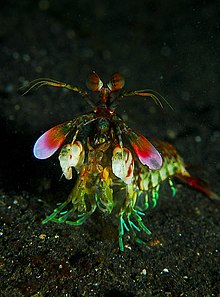|
Gonodactylus smithii
Gonodactylus smithii, also known as the purple spot mantis shrimp or Smith's mantis shrimp, is a species of the smasher type of mantis shrimp.[2] G. smithii are the first animals discovered to be capable of dynamic polarization vision.[3] They are identified by their distinctive meral spots ranging from maroon to purple with a white ring, though those that inhabit depths below 10 meters tend to be colored maroon.[4] They also have raptorial dactyles, specialized forelimbs that are pigmented green and red, and antennal scales that are yellow.[4] BackgroundGonodactylus smithii are aggressive benthic marine predators that exhibit highly specialized color vision.[5] On average, they are around 60 millimeters in length, but have been found to be as large as 380 millimeters.[5][4] The morphology of both males and females are isometrically proportional to their respective body masses.[6] Their mass ranges between 10 and 300 grams, with the average being around 60 grams.[4] Their basal metabolic rate ranges from 0.0125 to 0.02 cm3.02/g/hr, with the average being around 0.0175 cm3.02/g/hr.[4] DistributionGonodactylus smithii are found in tropical littoral zones in the Indo-Pacific Ocean, and widespread in Australia, India, and eastern Africa.[2][5] They are also found in regions south of Japan and around Guam.[4] Gonodactylus smithii reside in coral reef flats in both shallow waters and low intertidal depths ranging from 1 to 60 meters, but are most commonly found in the low intertidal zone.[2] Gonodactylus smithii typically dwell in the cavities they create in either live coral or coral rubble.[4] ReproductionGonodactylus smithii reproduce all year long, but breeding is more concentrated during warmer months.[4] They are generally monogamous, though some are polygynous.[4] Males usually pursue females in their native habitats.[5] Initially, males, using an external copulation organ, insert gonadopods into female gonadopores.[4] Sperm is released, with females holding the males briefly.[4] Females then release both the males and their eggs, with fertilization occurring.[4] Males typically leave after copulation and do not invest in the females nor their offspring.[4] Females are oviparous, laying eggs that eventually hatch.[4] Life stagesGonodactylus smithii have a bipartite life cycle.[7] They begin with a larval phase, during which dispersal occurs, then mature into an adult phase.[7] There are 7 larval stages, with the first 3 stages taking between 1 and 3 days, the fourth stage taking between 6 and 8 days, and the final 3 stages taking up to 38 days.[8] DietGonodactylus smithii utilize their smashing raptorial claws as a mechanism to catch prey.[4] The claws can easily shatter shells, stunning the prey.[4] Gonodactylus smithii are generally carnivorous, specifically preying on fish, molluscs, non-insect arthropods, crustaceans, bivalves, and gastropods.[4] MovementGonodactylus smithii are capable of many signaling behaviors and exhibit offensive and defensive actions while doing so.[5] Offensive actions include pushing the telson into the domicile of the resident, grasping the body of another using maxillipeds, and using dactyls to pierce through another.[5] Defensive actions include simply avoiding, and bending the abdomen so that it brings the telson underneath and up to the front.[5] BehaviorA behavior unique to Gonodactylus smithii is that they are capable of dynamic polarization vision.[3] Unlike other organisms, stomatopods only fixate their gaze on objects of interest from time to time.[3] They are able to focus their eyes with a series of rotations, and their eyes are capable of moving independently of the other.[3] One type of rotation they use is torsional rotation, in which their ability to see the polarization of light is amplified.[3] They rotate their eyes so that certain photoreceptors are aligned with the angle of polarization of a linearly polarized visual stimulus.[3] This allows them to isolate the contrast between the object of interest and its background.[3] The study of the eye structure of Gonodactylus smithii can generate more information on digital and visual storage capacity.[4] Roles in ecosystemGonodactylus smithii are essential to their ecosystem as they provide habitats for other organisms.[4] The cavities that they create are left behind for other organisms to dwell in, and some host parasites, though this has led to the contracting of diseases in their shells.[4] Bibliography
References
|
||||||||||||||||||||||||||
